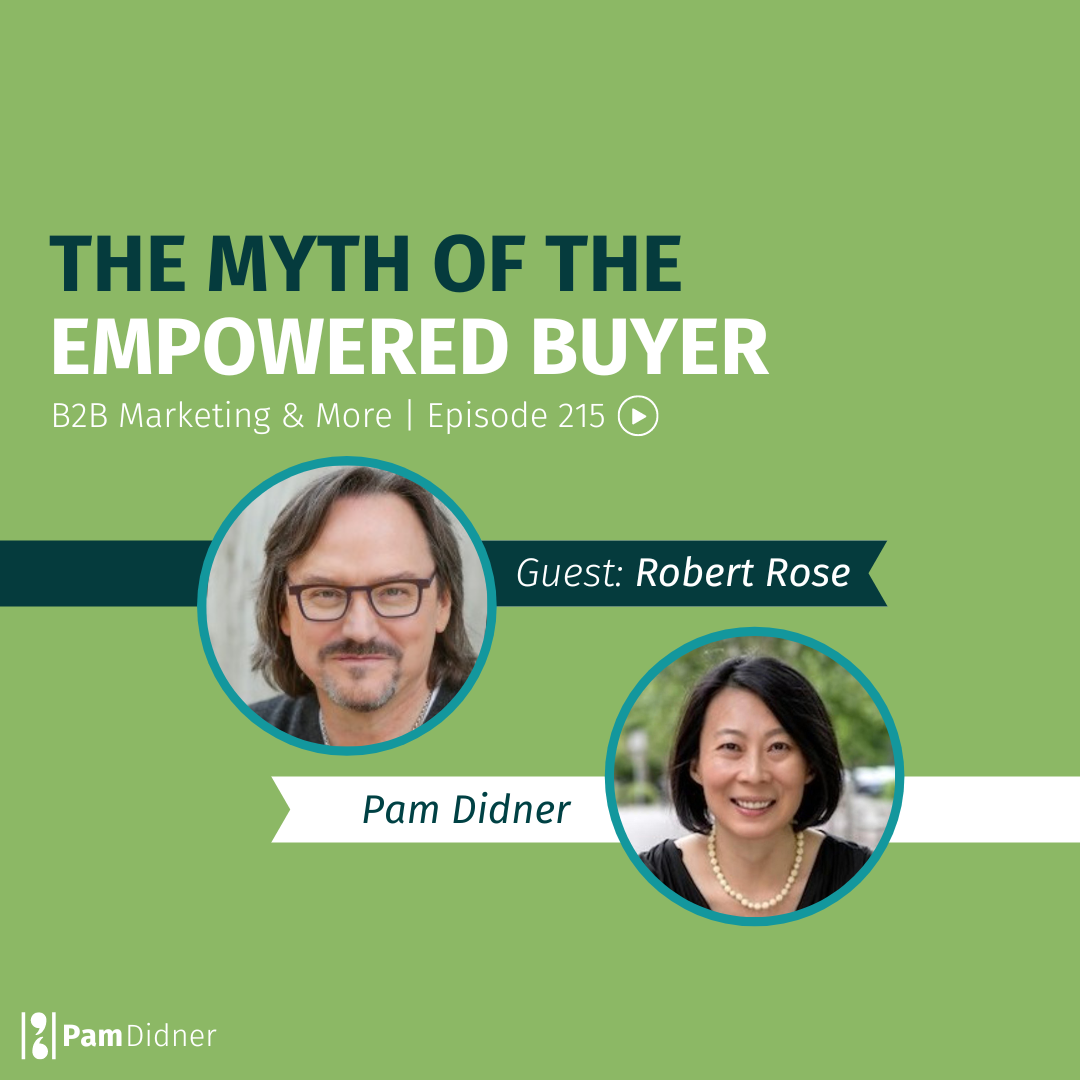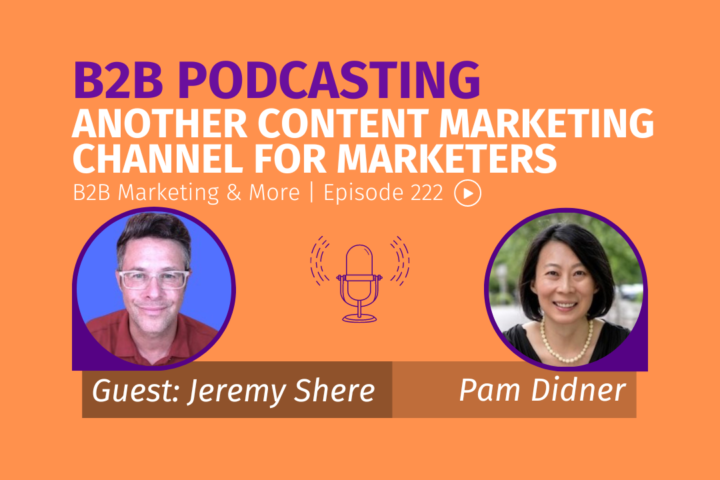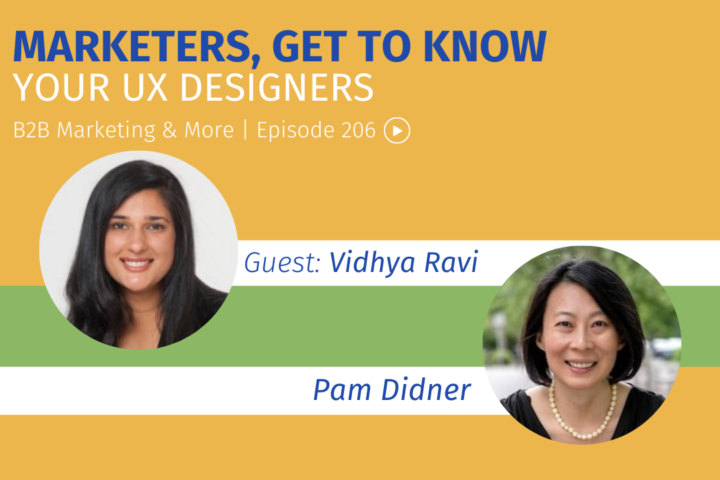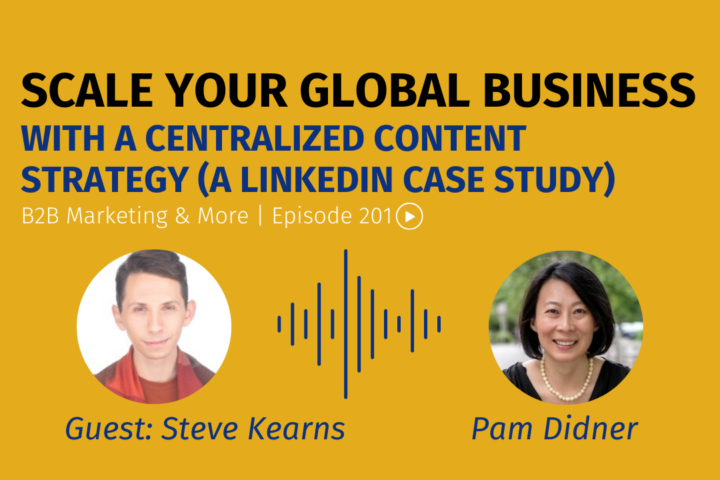
Hey, big hello from Raleigh, North Carolina. Welcome to another episode of B2B Marketing and More with Pam.
I have a very good friend joining me, Robert Rose, Chief Strategist of Content Marketing Institute. Robert and I have known each other for at least, I would say, 10 years.
Today, we are going to talk about our favorite topic – the B2B buyers. In the past several years, there’s been a term called empowered buyer. Many of them are good at consuming and researching high-quality content pieces. However, does that mean they are totally in control and incredibly knowledgeable?
In this episode:
- Who is the empowered buyer?
- How to approach knowledgeable and empowered buyers?
- How do discover the needs of the empowered buyer?
- What is the role of automation, and how to use it to improve customer experience?
- What type of communication and content do the new type of B2B buyers prefer and value?
Quotes from the episode:
” What happens is that our buyers are showing up and all we’re doing is pouring more research on them and not adding any value to their process because they’re just trying to check a box that they did all this research.”
“There are a couple of things, I think, that have been accelerated from the pandemic. And the first we were just talking about is the need for different kinds of content.”
—————
Enjoy the podcast? Subscribe to the show on your favorite podcast platform, leave a 5-star review, and subscribe to Apple Podcasts.
If you prefer watching a video, I also have a YouTube Channel; check it out and subscribe.
If you want to chat, reach out to any social media channels or email me at hello@pamdidner.com. You can also join my Facebook community: Build Your Marketing Skills to Get Ahead. When you join, you get a free Starbucks on me. You can go to the Announcement tab and click on the barcode of the gift card.
To expand your knowledge about the empowered buyer, check out some of my previous podcast episodes, blog posts, and video.
Podcast episodes
Marketers, Get to Know Your UX Designers
With Buyers in Control Sales and Marketing Must Align
Marketers Can Make An Impact on Buyer Research and Sales Engagements
Blog post
How The Best Sales Reps Set Themselves Apart From Competition
7 Steps To An Effective Lead Generation Process
Video
How to Use Data-First Strategy for B2B Marketing Success
TRANSCRIPT
Hey, big hello from Raleigh, North Carolina. Welcome to another episode of B2B Marketing and More with Pam. Yay. Today, I have a very good friend joining me, Robert Rose, Chief Strategist of Content Marketing Institute. And I have known Robert for at least, I would say, 10 years maybe. We have known each other for a long while.
Robert Rose: Yeah. It’s been the better part of a decade, for sure. Yeah.
Pam Didner: Yeah, exactly. Welcome to my show. I have waited so long to have you. Shame on Pam!
Robert Rose: I’m so excited to be here. I’m a long time listener and first-time guest. I’m super happy to be here. Thank you.
Pam Didner: Excellent. And today, we are going to talk about our favorite topic, which is buyers, the B2B buyers.
In the past several years, there’s been a term called empowered buyer, especially the B2B buyers. And they have all the information at their fingertips, AKA Google search, so they are armed with so much knowledge. And many of them are very, very good at consuming and researching high-quality content pieces to ensure that they have enough knowledge to source the right technology. Does that mean they are totally in control and incredibly knowledgeable about the technology and the platforms they need to buy? What is your thought on that?
Robert Rose: Well, we’ve been noticing more and more over the last few years because our business isn’t the only one doing content marketing. Our competitors are doing it. Everybody’s doing it, in some cases. And what has come to pass is that in many ways, businesses have this belief that there’s this asymmetric relationship between them and buyers, and buyers are showing up on their door, and that’s true.
The stats from Forrester or Gartner, the other research firms, say 70% of the buyer’s journeys are done before a salesperson gets a call, and people don’t like cold calling and all that stuff. It’s all true, but the question underneath it is what’s important, which is why. And the key is there’s research to show this: buyers aren’t feeling empowered these days.
We have to remember that the selling and marketing process is not the only one that has changed.
The buying process changed as well. And in many cases, those buyers are not doing this because they love it. It’s like asking me to buy a new something for my car engine. I hate cars. I don’t want to get into a car, but I’m going to research it and learn about it to buy the best one.
In many cases, for B2B, that’s the same thing. One CMO told me one time: “Look, we’re going out and buying this enterprise marketing technology, but I got no interest in learning and becoming a subject matter expert. I hate this. I don’t want to do it, but I have to do it because my boss, the CEO, wants us to put this committee together to buy the best-purchased product that we possibly can.”
And so many times, what happens is that our buyers are showing up and all we’re doing is pouring more research on them and not adding any value to their process because they’re just trying to check a box that they did all this research.
It’s the equivalent of saying we’ve got buyers showing up on our doorstep and they want to learn how to play chess, and we continually give them more research on why chess is such an important game, and they’ll have fun playing it. They’re like, “Yeah, I get it, enough.” And we just need to be more helpful. Instead of teaching buyers why to change, we need to be teaching them how they can change more easily.
Pam Didner: With that being said, how do we know what they want and how can we be helpful to them in a way that they need it?
Robert Rose: We can start listening to a lot more. That is what we can do.
Pam Didner: That is true. I 100% agree with that.
Robert Rose: Look, we’re marketers, so we are trained. There’s that wonderful, active listening idea. And the idea is that we’re waiting to speak. Are we listening, or are we just waiting to speak? And most marketing or sales enablement teams they’re pretty much just waiting to speak. It’s like, “Yeah, yeah, yeah. I hear what you’re saying, but how many licenses do you need?” So we can listen a lot more about hearing the buyers’ intent that are showing up. What are they looking for? When they ask or come in and download a piece of content, how many B2B companies do you know treat every single download of every piece of content the same way?
Pam Didner: Same. They assign the score. You download this piece; you get 30 points; you download that piece, you get 40 points.
Robert Rose: Exactly, MQL is triggered, and all of a sudden, it triggers an email saying, “How many licenses or what would you like to buy today and can I schedule a call with you?” And instead, if we start listening for the contextual signals, what we’re putting out with all of our thought leadership and marketing content are signals that can get tripped. And so if we look and say someone downloaded a White Paper entitled “Everything I Need to Learn About the Introduction of My Industry versus How Do I Implement the Best Solution for My Need”,. Those are two very different signals.
We can start responding in appropriate ways instead of treating both customers the same.
Pam Didner: I completely can relate to what you are just sharing with us in terms of that the lead score or the content score related to the download. Even if you assign a specific point or a score associated with someone downloading it, don’t use that number as, “Oh, you got 85 points; therefore, we should do this.” Even though they download a specific piece of content, you have to research to understand where they’re coming from. What else do they do? Try to identify their intent or interest before determining how you want to respond to that. It sounds like the automation workflow will not work very well, or you have to use a certain algorithm to attest or discover what that intent is. Is that correct? You have to do it manually or use some tool to help you out.
Robert Rose: We all tend to want to over automate things that don’t necessarily need to be automated.
But there are ways certainly to think about this from a marketing automation perspective. I think the key thing is not to just look. You said it very well. It’s not just looking at how many things they downloaded and assigning a score or even looking at exactly what they downloaded and assigning a score. One of the things that we need to look at is in the context of how those things happen. In other words, the order is important.
If someone comes in and downloads the paper that I just mentioned that says, “How do I implement X kind of solution,” and then goes and downloads the, “What do I need to learn about this particular industry?” well, that’s two different ideas, rather than if they came in and did the reverse. One is I’m learning, and then I need to know HOW. The other is maybe I need to check off a box and get to the how, but then I’m confused by everything, and I’m coming back to learning the why.
Understanding the context of what the customer is doing and what they’re asked…
One of my favorite things to do, and so few B2B companies do it, is instead of gating a piece of content with your email address, why don’t you gate a piece of content with just, “Why do you want this content?” Just ask. Just say, “What are you looking for?” “I’m just looking to learn. I’m trying to get as much research as possible to figure out what’s best for me.” Get insight and listen. Even if you only did that for one out of every five visitors, just start to get an insight and listen more than simply just waiting to speak.
Pam Didner: I like that you ask a very simple question even if you gate the content. Everybody wants to get the first name, last name and email address.
Robert Rose: Right. Well, they want the email address because we’ve started to equate that with value.
Pam Didner: I guess it’s probably another thing to check off the box. Guess what? I got another lead.
Robert Rose: Yeah, exactly.
Many companies have this algorithm set up to where somebody downloads something and immediately trips up an email to say set up a thing …
It happens to me all the time. I go to some site, and I download a white paper.
Pam Didner: Oh yeah. Honestly, I’m the guilty one. I set up that process myself, somebody subscribes, and I have three emails over three weeks. In the first one, you just welcome them and then share with them some content. And the second one is to say, “Hey, these are the top five popular most downloaded blog posts.” And then the other one-
Robert Rose: That’s right. That’s what you should be doing, but it’s the company that I go to. I’m looking at you, Gartner, when I go, and I download something available on Gartner and not five seconds later, do I get some sort of sales email saying basically-
Pam Didner: Sound like an automatic email, a hundred per cent.
Robert Rose: Automatic email saying basically. And if you think about it, the minute I’ve downloaded a White Paper is the worst time to email me and try and sell me something. It’s the worst time because I haven’t even read the thing that I’ve downloaded yet. I haven’t even experienced it yet. And you’re already banging on my door saying, “Hey, can I sell you something?”
Pam Didner: Hello, I need to talk to you now.
Robert Rose: If you could pick the worst time to try and sell somebody something, it would be the 5 or 10 seconds after they’ve downloaded this thing you wanted them to download, yet we do it. It’s the first thing we want to do.
Pam Didner: Yeah. I want to wait for a little bit, two or three days down the road, even when I do a workshop. Even for CMW, I will send a thank-you note, but usually, I send that right away, 24 hours, because I just say, “Hey, thank you so much for coming to my workshop,” and that’s about it. And then I have a call to action. “If you need to talk to me, feel free,” and that’s the end of the conversation. And I don’t usually do a lot of pounding, like, “Hey, talk to me, talk to me, talk to me.” But whenever I get a chance, I always have a call to action. “Yeah. It’s complimentary. Schedule a call with me,” so yeah, but I hear you. You don’t want to be right there that minute.
Well, now we are looking ahead, which is the post-pandemic.
Based on what you have seen and some of the research conducted by the Content Marketing Institute, what should marketers do differently? Now it’s a completely different era?
Robert Rose: There are a couple of things, I think, that have been accelerated from the pandemic. And the first is we were just talking about is the need for different kinds of content. There’s a statistic that I read. It was a few, maybe a month or two ago. I talked about how B2B organizations pivoted and started doing much more of their sales enablement online and in live video versus getting on a plane and showing up and doing PowerPoint presentations at the foot of the table or taking their customers to golf or whatever it is.
And what the report said was basically that companies have found success with that.
They’ve found that it’s better, in many ways. And so I think that’s one of the things that’s changed post-pandemic that will continue to be there, which is a real press on the need to create digital experiences that are video-based, that are sales-enablement oriented.
And so, I think there’s a real opportunity for marketers and salespeople to work together to create these very interesting, engaging, and thoughtful video experiences that are sales enablement practices repeatedly. A lot of that has to do with the real move here to create so much more digital content in a world where the physical aspects of this, our attendance at conferences and our attendance at being able to see people in restaurants and being able to go and fly there and do all those things, right now is really limited.
And so this move for a more direct digital customer experience is such an important part of this.
So that means that content marketers, the thought leadership, the resources, all of those kinds of things, are starting to merge a lot with other elements of content that are more sales-oriented. I think that expansion and importance as a strategy is probably the biggest thing to come out for content from the pandemic.
Pam Didner: When I was speaking, actually, at private events, they asked me about a specific trend that they need to pay attention to, especially looking ahead for the next two or three years. I say something similar but use a slightly different term. It’s the increased digital touchpoint. In the past, you could take care of that through any kind of physical interaction, but that is not just replaced but also there’s an increased number of digital touchpoints that you have to add as a part of the purchase journey.
Robert Rose: That’s a great point.
Pam Didner: And I agree with you. I have seen that as well. And I also have encouraged a lot of sales professionals. It’s very interesting about salespeople.
When you put a salesperson in front of a prospect, they are charming.
They know what to say and how to do it. But if you put the salesperson in front of a camera, they freeze. They’re like, “I don’t know what to say.”
Robert Rose: That’s such a great point. Yeah.
Pam Didner: And so one thing I feel that the sales professional that needs to possess in the future is the ability to look at a green dot, like a green dot on that digital camera, and still feel incredibly comfortable in talking, just like you are talking to prospects.
Robert Rose: That’s such a great point.
Pam Didner: Do you know there is a tool called Loom, L-O-O-M?
Robert Rose: I’ve heard of it. Yes.
Pam Didner: Loom. Yeah. Basically, it’s a SaaS-based platform that you can download to your laptop, and you can click on Loom, and then you can do recording like this. You can say, “Hey. Hey, this is Pam. It’s so good talking to you, blah, blah, blah,” and then you can hit done. And then you can do a very quick trim in and trim the front. You can trim the end, and then once that’s done, they give you a video link, very similar to YouTube.
So you can just add that link or add that video directly to your email, a very quick download, and it’s readily available. If you don’t want to add that video to your email, you can just add a video link so that people can watch it. It’s wonderful. And it’s also very, very good at doing a live demo. For example, I say, “Hey, Robert, you know what? I know you are interested in this. Let me show you how to do it.” And then you do it and record yourself. It was a wonderful tool. Yeah.
Robert Rose: Yeah. I’ve seen a couple of them. Yeah. It’s great for email.
Pam Didner: Yeah, exactly. No, I 100% understand. And I do encourage a lot of sales professionals. I say, “You know what? You look gorgeous. You know you are, so now you just get comfortable in front of the camera. Okay? Then you are perfect. All right?” Am I crazy?
Robert Rose: Yes, but we knew that already.
Pam Didner: All right. So this is wonderful, and I have one last question. So what show are you binge-watching right now?
Robert Rose: It’s hard to binge watch anymore because they’re all dropping once a week now, instead of dropping the whole season at a time.
Pam Didner: I know. That just annoys the heck out of me. Yeah.
Robert Rose: Yeah. The last binge-watch where we watched two seasons’ worth of shows in two weeks was “Yellowstone.” I just finished all four seasons.
Pam Didner: Oh my God.
Robert Rose: It’s so great.
Pam Didner: Is it by Kevin Costner? Yeah. I think that show is. Is it?
Robert Rose: Well, first of all, he’s dreamy, but …
Pam Didner: I know. That’s why I say. He ages so well. Oh my God. I love him. I have not watched that show. It’s on my list.
Robert Rose: Oh, you should watch it. It’s “The Sopranos”, as cowboys is what it is. It’s just so great.
Pam Didner: Really? Oh my God. What about the scenery? The Yellowstone, Grand Teton …
Robert Rose: Oh, it’s beautiful. It’s beautiful to watch. And it’s great.
If you like cowboys and westerns, it’s really fun. And then, of course, I’m watching all this new Star Trek stuff right now because I’m a nerd that way.
Pam Didner: “Picard,” are you watching the …
Robert Rose: Oh yeah. I watched all of it. I watched all of “Picard.” I’m in the “Strange New World.” I’m all over anything Star Trek, so that’s my favorite thing.
Pam Didner: Very good. Excellent. You know what, Robert? It’s so good talking to you, and I’m so happy that you finally came to my show we talk about what empowers buyers and how to be helpful to them. We talk about some of the digital touchpoints that will probably continue to increase post-pandemic and how to use video to engage with your prospect. Very, very good. So happy to see you, Robert.
Robert Rose: Great to see you.
Pam Didner: Take care. Bye.



